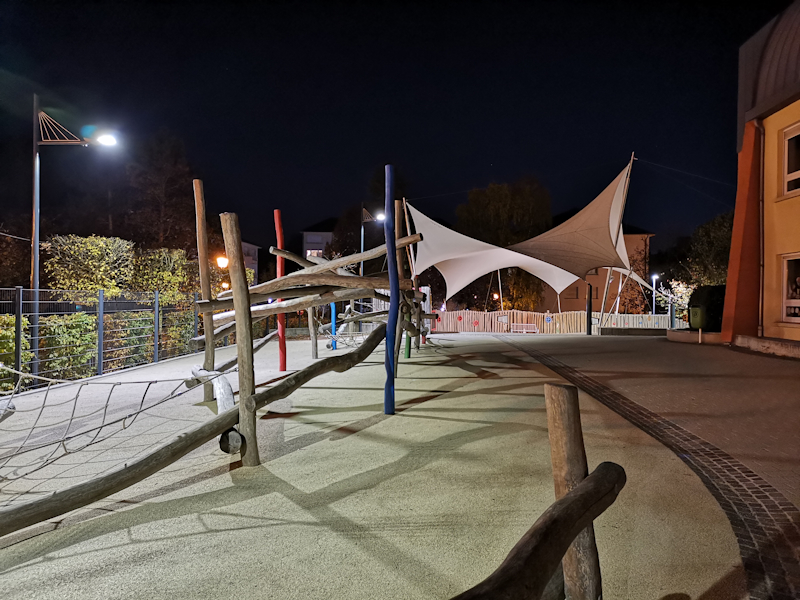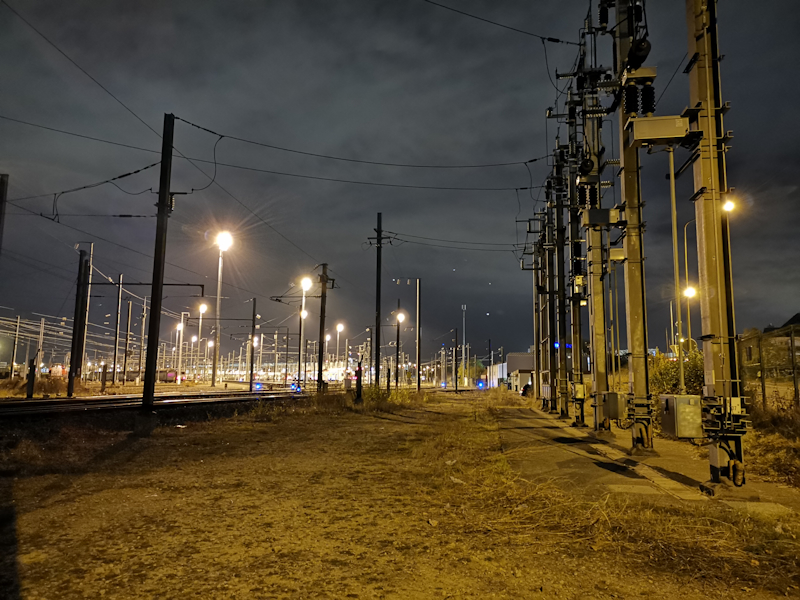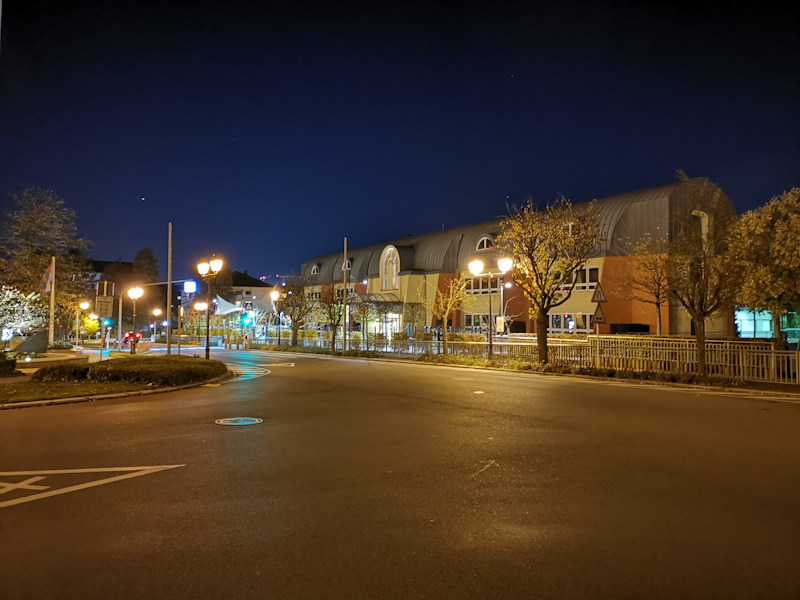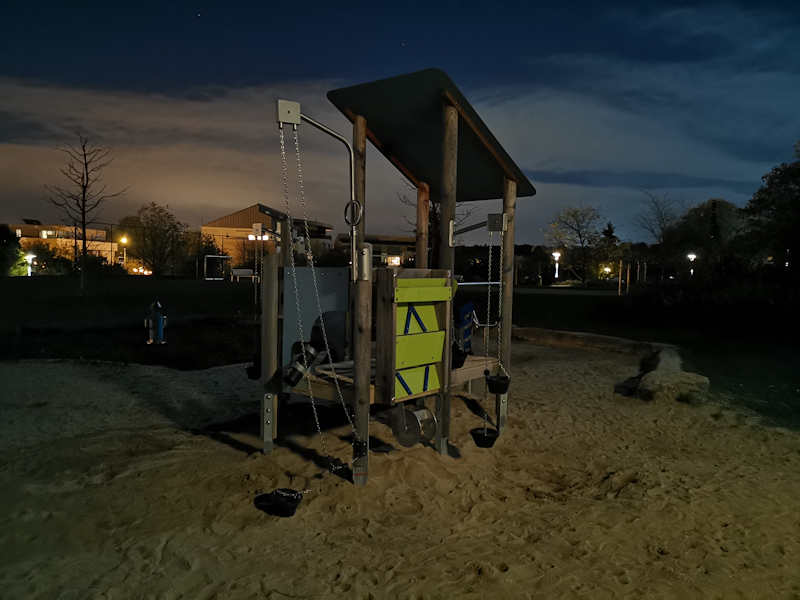The Mate 20 & Mate 20 Pro Review: Kirin 980 Powering Two Contrasting Devices
by Andrei Frumusanu on November 16, 2018 8:10 AM EST- Posted in
- Smartphones
- Huawei
- Mobile
- Kirin 980
- Mate 20
- Mate 20 Pro
Camera - Low Light Evaluation - Night Sight
Low-light capture was a forte for Huawei this year, as they were the first to introduce a low-light mode that was able to capture vastly superior exposure shots without having to use a tripod. The results on the P20’s were excellent, so let’s see how the new Mate 20’s fare.
[ Mate 20Pro ] - [ Mate 20 ] - [ P20Pro ]
[ P20 ] - [ Mate 10Pro ] - [ Pixel 3 ] - [ Pixel 2 ]
[ Pixel XL ] - [ iPhone XS ] - [ iPhone X ] - [ Note9 ] - [ S9+ ] - [ S8 ]
[ LG G7 ] - [ LG V30 ] - [ OnePlus 6 ] - [ OPPO FindX ] - [ MIX2S ]
In the first scene, the Mate 20 Pro goes off to a bad start as noted focus issues when capturing the scene. Here the phone multiple times took out of focus captures, with none of my night mode shots actually ending up in focus. In the regular mode, the Mate 20 Pro’s camera switches over to its unique high ISO mode and is able to deliver great results at ISO25600. We have to remember that the phones don’t actually have OIS, so again like on the P20 Pro this is quite remarkable. Also a big change compared to the P20 Pro is the colour rendition, here the Mate 20 Pro is able to extract much better colours out of the scene, and all while reducing noise significantly.
The Mate 20’s regular mode isn’t all that impressive as pretty much in line with how most sensors behave in low light. Here turning on Night mode is a requirement, and greatly improves the picture quality.
Google’s new Night Sight mode outmatches Huawei’s phones in terms of light capture, noise and detail retention, however the images is so bright that it’s less natural than the Mate’s results.
[ Mate 20Pro ] - [ Mate 20 ] - [ P20Pro ] - [ P20 ]
[ Mate 10Pro ] - [ Pixel 3 ] - [ Pixel 2 ] - [ Pixel XL ]
[ iPhone XS ] - [ iPhone X ] - [ Note9 ] - [ S9+ ] - [ S8 ]
[ LG G7 ] - [ LG V30 ] - [ OnePlus 6 ] - [ OPPO FindX ] - [ MIX2S ]
The second scene the Mate 20 Pro does a very different exposure to the P20 Pro, the latter did a much more accurate representation of the brightness and colour temperature of the sodium street lamps. Turning on night mode improved things a lot for both phones.
Overall the Mate 20’s are among the best low light shooters thanks to night mode, only recently dethroned by Google’s Pixel phones.
[ Mate 20Pro ] - [ Mate 20 ] - [ P20 ]
[ Mate 10Pro ] - [ Pixel 3 ] - [ Pixel 2 ] - [ Pixel XL ]
[ iPhone XS ] - [ iPhone X ] - [ Note9 ] [ S9+ ] - [ S8 ]
[ LG V30 ] - [ OnePlus 6 ] - [ OPPO FindX ]
The next scene the Mate 20 Pro varies in its results while in auto mode. The first shot has better dynamic range and also better detail retention, here Huawei needs a way to keep things more consistent. The regular mode on the Mate 20 is also good, although it’s lacking in texture detail as well showing some very weird blur in the right part of the image. Here I think the lack of OIS is hampering the phones.
Turning on night mode again improves the quality, but again the regular Mate 20 is giving out some blurred results here as its multi-frame stacking doesn’t seem to work correctly.
I would say the Mate 20 Pro along with the Pixel’s Night Sight modes are leading closely together.
[ Mate 20Pro ] - [ Mate 20 ] - [ P20Pro ] - [ P20 ]
[ Mate 10Pro ] - [ Pixel 3 ] - [ Pixel 2 ] - [ Pixel XL ]
[ iPhone XS ] - [ iPhone X ] - [ Note9 ] - [ S9+ ] - [ S8 ]
[ LG G7 ] - [ LG V30 ] - [ OnePlus 6 ] - [ OPPO FindX ] - [ MIX2S ]
Partial blurriness is again an issue of the Mate 20 in this scene. The Mate 20 Pro doesn’t have any issue in this regard, and captures the best regular mode shot among all phones.
Switching to night mode, it brightens up things for both units, and also resolves the blurriness issue on the Mate 20. Although Huawei’s phones are showcasing more realistic exposures, the Pixel phones night mode outclass them in terms of detail retention.
[ Mate 20Pro ] - [ Mate 20 ] - [ P20Pro ] - [ P20 ]
[ Mate 10Pro ] - [ Pixel 3 ] - [ Pixel 2 ] - [ Pixel XL ]
[ iPhone XS ] - [ iPhone X ] - [ Note9 ] - [ S9+ ] - [ S8 ]
[ LG G7 ] - [ LG V30 ] - [ OnePlus 6 ] - [ OPPO FindX ] - [ MIX2S ]
This scene again showcases some big blur issues on the regular Mate 20’s auto shots that are only resolved by turning on night mode. The Mate 20 Pro’s auto mode here produces the most natural result out of all phones.
In night mode, things brighten up a bunch, and Huawei manages much better results than other devices, but is yet again beat by Google’s new software.
Extreme low-light
Extreme low light scenarios is something as early as last year we wouldn’t have expected phones to be viable in. Again I started shooting such scenes earlier in the year when Huawei made its Night mode usable without a tripod – along with vendors like LG introducing pixel binning modes that quadruple the light capture of the sensors.
[ Mate 20Pro ] - [ Mate 20 ] - [ P20Pro ] - [ P20 ]
[ Mate 10Pro ] - [ Pixel 3 ] - [ Pixel 2 ] - [ Pixel XL ]
[ iPhone XS ] - [ iPhone X ] [ Note9 ] - [ S9+ ] - [ S8 ]
[ LG G7 ] - [ LG V30 ] - [ OnePlus 6 ] - [ OPPO FindX ] - [ MIX2S ]
In extreme low light scenarios, the Huawei phones were in a league of their own until just very recently. The Mate 20 Pro in its regular mode relies on ISO25600 to achieve a very good shot, beating all other phones including the P20Pro. The Mate 20 doesn’t fare as well here as its sensor just can’t capture enough light.
In night mode, the Mate 20 Pro gains in sharpness and sheds some of the noise, and the Mate 20 now manages to sufficiently light up the scene, although sharpness and detail aren’t too good. Although the Huawei again have a better natural reproduction of the light in the scene, Google’s night sight just produces a just ridiculously brighter scene that offers significantly better details.
[ Mate 20Pro ] - [ Mate 20 ] - [ P20Pro ] - [ Mate 10Pro ]
[ Pixel 3 ] - [ Pixel 2 ] - [ Pixel XL ]
[ iPhone XS ] - [ iPhone X ] - [ Note9 ] - [ S9+ ] - [ S8 ]
[ LG G7 ] - [ LG V30 ] - [ OnePlus 6 ] - [ OPPO FindX ] - [ MIX2S ]
Finally, in the darkest possible conditions, in a path under the light of the moon, the Mate 20 Pro and P20 Pro are the only camera sensors able to capture anything, with the Mate 20 Pro using its maximum ISO102400 mode. The Mate 20 largely remains blind. Night mode on the Mate 20 Pro actually regresses things in these conditions, while on the Mate 20 it allows to finally make out some parts of the scene.
Again both phones are beat by Google’s new night sight, achieving some pretty astounding results.
Low-light conclusion
Overall in low light conditions, the Mate 20 Pro is a clear leader in terms of its hardware capabilities. Just like on the P20 Pro, the massive sensor as well as is high ISO capabilities prove very beneficial for the phone.
The Mate 20 fared less well in regular mode, and underperforms most other flagships. Here the use of night mode is a requirement to get better shots out of the phone.
Up until recently this would have been the end of my conclusion, but the recent introduction of Google’s new night sight mode means that Huawei no longer is the best in low-light conditions. While I do feel that Google is overdoing it a bit and Huawei still produces the more realistic and representative exposures, the Pixel phones just have a tremendous detail and noise reduction advantage. Still, this is not to take away from Huawei’s great low-light performances, as it still stands above that of many other devices.

















141 Comments
View All Comments
name99 - Friday, November 16, 2018 - link
Andrei you are concentrating on the wrong thing. I don't care about the inadequacies of GB4's memory bandwidth test, or the device uncore, I care about the DRAM part of this.I understand you and anomouse are both claiming that LPDDR4-2133 means 4266 MT/s.
OK, if that's true it's a dumb naming convention, but whatever. The point is, this claim goes directly against the entire thrust of the anandtech DDR5 article from a few days ago that I keep referring to, which states very clearly that something like DDR4-3200 means 3200MT/s
THAT is the discrepancy I am trying to resolve.
ternnence - Friday, November 16, 2018 - link
name99 , for mobile,LPDDR4x has 4266 spec , however desktop DDR4 rarely could get such frequency. So it is not LPDDR4-2133 has 4266MT/s, it is LPDDR4-4266 has 4266MT/sternnence - Friday, November 16, 2018 - link
FYI,https://www.samsung.com/semiconductor/dram/lpddr4x... you could check this site.name99 - Friday, November 16, 2018 - link
FWIW wikipedia sees things the same way saying thathttps://en.wikipedia.org/wiki/DDR4_SDRAM
eg DDR4-2133 means 2133MT/s
This follows the exact same pattern as all previous SDRAM numbering. Up to DDR3 the multiplier was 2 (DDR), 4(DDR2) or 8(DDR3); with DDR4 the multiplier stays at 8 but the base clock doubles so from min of 100MHz it's now min of 200MHz.
But these are internal details; the part that matters is that most authorities seem to agree that DDR4-2133 means 2133MT/s, each transaction normally 64-bits wide.
Now there are SOME people claiming no, DDR4-2133 means 4266 MT/s
- https://www.androidauthority.com/lpddr4-everything...
claims this (but couches the claim is so much nonsensical techno-double-speak that I don't especially trust them)
- so do you and anonomouse.
So, like I said, WTF is going on here? We have a large pool of sources saying the sky is blue, and a different pool insisting that, no, the sky is green.
anonomouse - Friday, November 16, 2018 - link
I never claimed that DDR4-2133 means 4266MT/s. I am instead claiming that there is no LPDDR4-2133.anonomouse - Friday, November 16, 2018 - link
I think the discrepancy here is just that you/they are mixing the naming conventions. DDR4-3200 means 3200MT/s. After an admittedly brief and cursory search, I don't see any references to Micron using the term LPDDR4-2133. I instead see every indication that they have LPDDR4 running at 2133MHz. Perhaps people here and there are mixing up the terminology, but when in doubt may as well just look at the actual memory clock or bandwidth being listed as that's ultimately what's importantly.name99 - Friday, November 16, 2018 - link
Yeah, I think you are correct. After looking in a few different places I think the following are all true:- The DDR4 guys tend to talk about MT/s and give the sorts of numbers I gave
- The LPDDR4 guys tend to talk about Mb/s per pin (same as MT/s, but just shows a different culture) and tend to be working with substantially higher numbers.
I *THINK* (corrections welcome) that
(a) the way LPDDR4 is mounted (no DIMMs and sockets, rather it's direct mounting, either on the SoC as PoP, or extremely close to it on a dedicated substrate), allows for substantially higher frequencies than DDR4.
(b) one's natural instinct (mine, and likely other people's) is that "of course DDR4 runs faster [fewer power concerns, etc]" so when you see LPDDR4 running faster (at say "4266") you assume this has to mean some sort of "silent" multiplication by 2, and what's actually meant is the equivalent of DDR4-2133 at 2133MT/s.
(c) It certainly doesn't help that Micron at least is calling the 4266MT/s LPDDR4 as having a "2133MHz clock". I have no idea what that is supposed to mean given that the DDR4 "clock" runs at 1/8th transaction speed, so for DDR4 the clock of a 4266MT/s device would be 533MHz.
So I think we have established that the actual speeds ARE 4266MT/s (or so) for LPDDR4.
Left unresolved
- these are generally higher than DDR4? Meaning that, sooner or later, PC users are going to have to choose between flexible RAM (DIMMs and sockets) or high speed RAM (PoP mounting, or superclose to the SoC on a substrate --- look at the A12X)?
- Why is Micron calling something like LPDDR4-4266 as having a 2133MH clock? What does that refer to? I would assume that, like normal DDRx, the "low frequency clock" (what I've said would be 533MHz) is the speed for control transactions, and the 8x speed (4266Mb/s per pin) is the speed for bulk data flow?
ternnence - Friday, November 16, 2018 - link
where do you get this "Micron lists their LPDDR4, for example, as LPDDR4-2133, NOT as LPDDR4-4266?"? just check Micron official site, they mark LPDDR4-4266, not LPDDR4-2133, to their 2133MHz ram.ternnence - Friday, November 16, 2018 - link
ddr means double data rate. 2133MH equals ram operates 2133 per second. but one operate produce two data output. MT/s equals million transfer per second. so LPDDR4-4266= 4266 million transfer per second = 2133 million Hzname99 - Friday, November 16, 2018 - link
The Micron datasheets, for example, numdram.pdf,https://www.micron.com/~/media/documents/products/...
do exactly this.